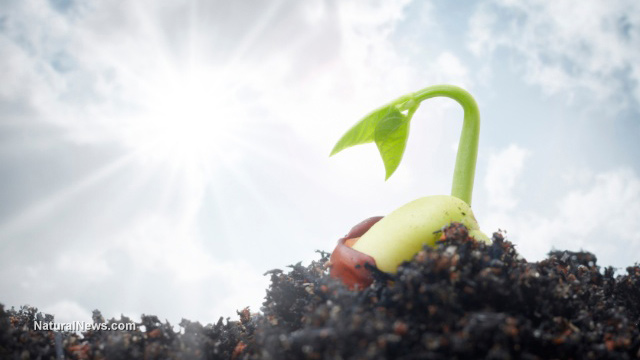Plants produce their own natural sunscreen to protect against ultraviolet radiation
Wednesday, February 03, 2016 by: David Gutierrez, staff writer
Tags: plant defenses, natural sunscreen, ultraviolet radiation

(NaturalNews) Scientists are beginning to uncover the mechanisms by which plants -- which depend upon sunlight to provide them with energy -- protect themselves from the damaging effects of the sun's ultraviolet rays. Most recently, in a study published in the Journal of the American Chemical Society, researchers from Purdue University helped illuminate the function of "natural sunscreens" that plants produce and use to protect their leaves.
For some time, researchers have known that the fact that plants get their energy from the sun does not make them immune to the effects of ultraviolet radiation. If anything, plants are even more vulnerable, as so much of their growth is driven by the need to maximize their exposure to sunlight. Recently, studies have begun to uncover the role that chemicals known as sinapate esters play in protecting them. Researchers have found that plants produce sinapate esters internally, then transport them to the surface of their leaves. Once there, the "natural sunscreen" blocks ultraviolet-B (UVB) radiation from penetrating the leaves and damaging the plant's structures or DNA.
Chemicals completely block dangerous rays
In the new study, the researchers made a sinapate ester gas, then bombarded that gas with UVB radiation. They found that the gas was incredibly efficient, successfully absorbing every single wavelength of UVB light.While plants produce "natural sunscreen" to protect themselves from UVB radiation, their defenses do not end there. No matter how good the sunscreen, plants inevitably take some damage from ultraviolet radiation, just like animals do.
A 2013 study -- conducted by researchers from Dartmouth University, the Salk Institute for Biological Studies and Australian National University, and published in the Proceedings of the National Academy of Sciences -- showed that plants respond to fluctuations in sunlight by using genetic signaling proteins called Heat Shock Transcription Factors to produce enzymes that detoxify the dangerous molecules that are formed when plants are exposed to very intense light.
Finely tuned healing mechanisms
Another recent study, led by researchers from Washington State University and also published in the Proceedings of the National Academy of Sciences, further examined the mechanisms that plants use to heal themselves from excessive UV exposure. According to corresponding author Helmut Kirchhoff, UV exposure inevitably causes the production of damaging free radicals, also known as Reactive Oxygen Species (ROS). These free radicals are also produced as natural byproducts of metabolism.Just as in humans and other animals, free radicals can damage the cells and DNA of plants, producing ill health or even death.
"ROS production can't be avoided, only minimized," Kirchhoff said. "It becomes a big problem for plants under unfavorable environmental conditions, like too much heat, too much light or insufficient nutrition."
The researchers examined the plant cell structures known as chloroplasts, which are responsible for photosynthesis. They found that free radicals tend to destroy very specific "nanomachines" found in the photosynthetic membranes of chloroplasts. These nanomachines are essentially tiny molecules that fulfill specific functions in the cell.
The study showed that just as certain nanomachines are damaged by free radicals, other nanomachines within the same membranes are responsible for repairing this damage. The repair happens in a series of discrete steps, with each step dependent upon the completion of the prior step. In each step, the repair nanomachine collects a specific protein from a unique region of the membrane, then moves to the next region to collect the next protein.
"Until now, it was not known how the order of events is guaranteed," Kirchhoff said. "Our results suggest that we have to understand the structural characteristics and dynamics of photosynthetic membranes to understand the repair of the energy-converting nanomachines. This has not been appreciated before."
Sources for this article include:
http://www.newswise.com
http://www.sciencedaily.com
http://www.sciencedaily.com
Plant defenses at FETCH.news
Get independent news alerts on natural cures, food lab tests, cannabis medicine, science, robotics, drones, privacy and more.
Take Action: Support Natural News by linking to this article from your website
Permalink to this article:
Embed article link: (copy HTML code below):
Reprinting this article:
Non-commercial use OK, cite NaturalNews.com with clickable link.
Follow Natural News on Facebook, Twitter, Google Plus, and Pinterest
- Chemtrails unveiled: How the CIA and Big Business are manipulating the weather for profit
- Mysterious underwater pyramid off Japan could rewrite ancient history
- New study confirms brown rice contains 40% more toxic arsenic than white rice, putting young children at risk
- Israeli lobbyists boast of controlling US national security policy in leaked AIPAC audio
- RFK Jr. gives food companies two years to remove harmful artificial dyes
- Over 30 pieces of evidence on how ‘the climate scam is collapsing’
- How to live without electricity: A practical guide for survival and preparedness
- Geoengineers forced into secrecy as public backlash grows: How climate elites are manipulating populations to accept geoengineering experiments
- The HEART-HEALING power of SEVEN Mediterranean plants
- Lightmatter's photonic breakthrough: A leap forward in AI efficiency and speed
- The media playbook for measles looks a lot like its COVID playbook - this time, kids are the pawns
- Tulsi Gabbard leads charge against the Biden regime’s global censorship of the 'Disinformation Dozen'
- Fauci is back in the limelight, and he’s busy promoting a future COVID or FLU pandemic
- Common household chemicals linked to America's depression epidemic
- Analysis: The coming economic collapse, a mass uprising and Trump's three secret weapons to halt the growing revolt
- The looming electricity crunch: A crisis of supply and demand
- Cottage cheese: A superfood source of protein and other nutrients
- Aerosolized bioweapons? Strange “diploid biomasses” falling out of the sky in Florida captured under the microscope
- Aerosolized bioweapons? Strange “diploid biomasses” falling out of the sky in Florida captured under the microscope
- Widespread social and economic unrest: Steve Quayle issues urgent financial warning of imminent asset collapse in new interview with Mike Adams
- CLOT SHOT PLANDEMIC UNFOLDING: Fibrous, rubbery clots caused by covid injections have prion-like seeding activity
- Analysis: The coming economic collapse, a mass uprising and Trump's three secret weapons to halt the growing revolt
- Kiss Your Genetic Privacy Good-Bye! 23andMe Gets Green Light to Sell Your Intimate Genetic Details to Anyone They Want
- Tulsi Gabbard leads charge against the Biden regime’s global censorship of the 'Disinformation Dozen'
- Mike Adams releases country western hit single: Goin’ Back in Time is Comin’ Home
- DEATH by VACCINE or face PRISON time: Canadian Freedom Convoy leaders CONVICTED for protesting forced vaccination during the Covid Plandemic
- Fauci is back in the limelight, and he’s busy promoting a future COVID or FLU pandemic
- How Israeli military-connected corporations are secretly controlling your online privacy
- European Court of Justice: Healthcare professionals who promoted or administered COVID-19 vaccines are CRIMINALLY LIABLE for any harm caused
- Defunding DEADLY mRNA jabs: Government funding for mRNA technology being scrutinized and sidelined until proven "safe and effective" for real
- Tulsi Gabbard takes aim at censorship: Justice for the ‘Disinformation Dozen’
- Federal employees whine over DOGE's new directive requiring them to do a 5-point summary of weekly accomplishments
- U.S. approves new Russian ambassador as diplomatic thaw continues
- I Want My Bailout Money – new song and music video released by Mike Adams
- Trump administration poised to overhaul crypto regulations with new SEC leadership
- I Want My Bailout Money – new song released by Mike Adams
- Newly released JFK files reveal Pentagon's role in creating Lyme disease and covid in the same lab
- Mike Adams releases country western hit single: Goin’ Back in Time is Comin’ Home
- Analysis: The coming economic collapse, a mass uprising and Trump's three secret weapons to halt the growing revolt
- MEDICAL BOMBSHELL: FDA admits Covid mRNA 'Vaccines' CAUSE CANCER
- Dr. Mike Yeadon releases 15-minute testimony - WATCH - about genocidal intent of COVID “vaccines”
- Trump reverses course on Gaza plan, says “nobody is expelling Palestinians”
- 5 Simple steps to boost your brainpower: How to strengthen executive function in a distracted world
- The Health Ranger releases “Vaccine Zombie” song and music video, using AI-animated zombies for the music video
- California's social media censorship law struck down: A victory for free speech or a threat to online safety?
- Rep. Nancy Mace introduces bill to ban biological males from female facilities on federal property
- EPA advisor admits the agency is funneling billions to climate groups ahead of Trump’s return to White House
- Survival 101: Effective EMF blocking techniques
- Aerosolized bioweapons? Strange “diploid biomasses” falling out of the sky in Florida captured under the microscope
- OpenAI whistleblower who dissented against how the company trained ChatGPT found dead
- Trump Administration cuts 2,000 USAID jobs, places most employees on leave in sweeping reform effort
- A lack of integrity in Academia: Harvard professor found GUILTY of fraudulent research to promote CRT theory
- Sugarcane extract superior to cholesterol-lowering drugs?
- RFK Jr.'s SSRI antidepressant investigation sparks liberal meltdown, exposes Big Pharma's dangerous game
- Red Cross issues warning to stop blood plasma donations from vaccinated people
- Scientists confirm: GENIUS brain function can be spontaneously unleashed in humans without any apparent cause
- EPA advisor admits the agency is funneling billions to climate groups ahead of Trump’s return to White House
- HYSSOP: What research reveals about the health benefits of this ancient holy herb
- Two containers with completed ballots fall out of truck in Florida
- Fully vaccinated about to see “tsunami” of illness and death, warns virologist
- Global leaders unite to clamp down on “misinformation” with UN-backed Cascais Declaration
- Newly released JFK files reveal Pentagon's role in creating Lyme disease and covid in the same lab
- BREAKING: 2025 NDAA authorizes mandatory military draft of WOMEN across America… as Pentagon pursues global NUCLEAR war with both Russia and China at the same time
- Michael Yon warns of a ZIONIST TAKEOVER in Trump’s second administration
- Ozempic and Wegovy weight loss drugs are injectable LIZARD VENOM PEPTIDES that may unleash a devastating wave of organ failure… side effects align with symptoms of SNAKE BITES
- The Health Ranger releases “Vaccine Zombie” song and music video, using AI-animated zombies for the music video
- BOMBSHELL: DNA testing kits are a SCAM to develop ethnic-specific bioweapons
- Israeli soldiers accused of even more torture and abuse in the West Bank
- These 13 countries just signed an agreement to engineer a global FAMINE by destroying food supply
- Mike Adams releases country western hit single: Goin’ Back in Time is Comin’ Home
- NASA admits that climate change occurs because of changes in Earth’s solar orbit, and NOT because of SUVs and fossil fuels
- RFK Jr. clears key hurdle: Sen. Susan Collins backs controversial HHS nominee, signaling a new era for health policy
Science News & Studies
Medicine News and Information
Food News & Studies
Health News & Studies
Herbs News & Information
Pollution News & Studies
Cancer News & Studies
Climate News & Studies
Survival News & Information
Gear News & Information
News covering technology, stocks, hackers, and more



"Big Tech and mainstream media are constantly trying to silence the independent voices that dare to bring you the truth about toxic food ingredients, dangerous medications and the failed, fraudulent science of the profit-driven medical establishment.
Email is one of the best ways to make sure you stay informed, without the censorship of the tech giants (Google, Apple, Facebook, Twitter, YouTube, etc.). Stay informed and you'll even likely learn information that may help save your own life."
–The Health Ranger, Mike Adams












































